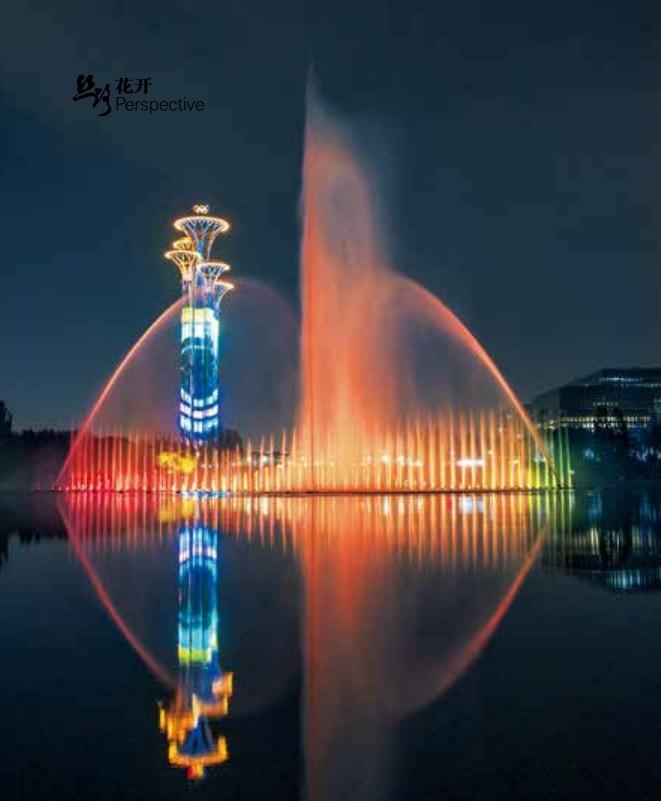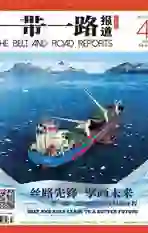亚洲文明 殊方共享
2019-09-10彭纳
彭纳

璀璨的亚洲文明,为世界文明发展史书写了浓墨重彩的篇章,人类文明因亚洲而更加绚烂多姿。我们应该增强文明自信,在先辈们铸就的光辉成就基础上,坚持同世界其他文明交流互鉴,努力续写亚洲文明新辉煌——中国国家主席习近平
The great Asian civilizations have a special place in the annals of world civilizations, and they have added to the diversity of human civilizations. We should have greater confidence in our civilizations. We may build on the rich heritage of our forefathers, stay engaged with other civilizations and increase mutual learning. By doing so, we will add new glory to Asian civilizations. — Chinese President Xi Jinping
当安纳托利亚高原上的小麦破土而出,它成为了哺育人类的乳汁;当水稻被河姆渡人种在长江流域的土地上,它供养着生命的世代传承;当朵朵棉花如云般绽放在古印度,它温暖着在岁月洪流中奋进的人们。这些给予人类生命延续力量的种子,拼接出亚洲这片土地关于文明的最初印象。
亚洲,在世界版图上,占据着陆地总面积的29.4%,被誉为“太阳升起的地方”。幅员辽阔的亚洲大陆,孕育出了瑰丽多彩的文明——延绵至今的中华文明、悠久古老的印度文明、神秘奪目的巴比伦文明。
四季交替,历史更迭。2015年3月28日,博鳌亚洲论坛开幕式上,中国国家主席习近平发表主旨演讲时说:"中方倡议召开亚洲文明对话大会,加强青少年、民间团体、地方、媒体等各界交流,打造智库交流合作网络,让亚洲人民享受更富内涵的精神生活,让地区发展合作更加活力四射。"
4年后,亚洲文明对话大会落地中国。这场关于文明的盛事,让来自亚洲的47个国家和世界其他国家及国际组织的1352位会议代表齐聚北京,围绕“亚洲文明交流互鉴与命运共同体”主题,共商亚洲文明发展之道,共话亚洲合作共赢大计。
5月的北京,被盛开的月季花装点,街头飞扬的彩旗延续到路的尽头,亚洲文明对话大会牡丹花形状的标志随风舞动,与路边盛放的鲜花遥相呼应。5月15日,亚洲文明对话大会缓缓拉开序幕,7天时间里,大会举办了开幕式及六场平行分论坛,与此同时,在全国同步开展亚洲文化嘉年华、亚洲文明周、亚洲美食节等活动,让全国各地的人们都有机会参与到这场文明的盛宴中。

5月15日晚上,“亚洲文化嘉年华”在国家体育场“鸟巢”上演,奏响了亚洲文明对话大会的盛大序曲。这场通过移动互联网,面向全球直播的文化狂欢大联谊让世界为之震撼。
来自亚洲各国的艺术家、青年代表及享有盛誉的世界级著名表演艺术家,在这个夜晚齐聚一堂,为世界打造了一台中外文明大交流、文化界大汇聚、人民大联欢的人文盛事。活动中,多彩多元的艺术呈现、全新的舞美科技以及中外艺术家和青年的精彩演出和互动,展示出亚洲文明的独有魅力和中国文明的博大瑰丽。
5月16日,亚洲文明对话大会的重要内容——亚洲文明巡游在北京奥林匹克公园景观大道拉开帷幕。孟加拉国、柬埔寨、印度等16个国家选派的表演团队以及来自我国各省市自治区的共28支优秀表演团队组成盛装巡游队伍,为现场观众带来了别样的亚洲风情。
活动以“亚洲文明 世界共融”为主题,以“文明对话、交流平台、‘一带一路’、世界共融”为理念,全方位展示亚洲各国风貌,通过“中华风采”“亚洲风情”“神州风韵”“北京欢迎你”四个表演板块,充分展现了亚洲文明的绚烂风情、中国文明的多姿多彩和北京文化的深邃魅力。精彩的表演赢得现场观众阵阵掌声。

熙熙攘攘的中国国家博物馆内,参观者络绎不绝。这座现代化的博物馆内有一方宝藏,隐藏着远古的文明之光。
走进“殊方共享——丝绸之路国家博物馆文物精品展”,文明交往的历史画卷便在一件件文物中缓缓展开。此次展览,中国国家博物馆联合“一带一路”沿线的柬埔寨、日本、哈萨克斯坦、拉脱维亚、蒙古、阿曼、波兰、韩国、罗马尼亚、俄罗斯、斯洛文尼亚、塔吉克斯坦12个国家博物馆,精挑细选各个时期、不同门类的234件(套)历史文物,实证丝绸之路沿线国家丰富多样的文化交流。
展品中,俄罗斯早期文明带着青铜时代的莽撞,将游牧文化带入中国,那些带有图尔宾诺文化符号的长矛,在新疆、青海出土;在蒙古国的展品中,来自中国和其他国家的各种钱币,成为了丝绸之路上贸易往来的有力证据;哈萨克斯坦黄金武士闪亮的盔甲,述说着丝路繁华的过往;玄奘笔下的塔吉克斯坦,在印有铭文的器物上,呈现眼前……
波兰华沙国家博物馆藏中国风格的伊朗瓷盘、柬埔寨国家博物馆藏铜鼓、韩国国立中央博物馆藏唐三彩三足罐、日本东京国立博物馆藏突线钮铜铎、阿曼国家博物馆藏哈德拉毛语雕刻饰板……精美绝伦、风格迥异的各国藏品,引得参观者驻足欣赏。这些精美文物充分展示了“一帶一路”沿线各国在科技、艺术领域的融合互鉴以及其交汇碰撞的广度和深度,同时也深刻揭示了构建人类命运共同体作为世界未来发展方向的历史必然性。
亚洲文明对话大会期间,以“文明之源 美美与共——璀璨的亚洲文明”为主题的亚洲文明联展(文物展)也于4月至8月在国家会议中心、清华大学艺术博物馆火热开展,这些带着文明基因的文物,会带领大众追溯亚洲各文明的发展历程,展现各文明之间的对话、交流、互鉴的轨迹,推动亚洲不同民族、不同国家、不同文明之间的交流互鉴。
美食是世界流行的通用语,没有一个人能够拒绝味蕾发出的邀请。
5月16日傍晚,成都春熙路人潮涌动。一场名为“舌尖上的以色列”的美食推介活动正式启动,拉开了亚洲文明对话大会成都熊猫亚洲美食节的序幕。活动现场,萨比奇煎饼、甜薯三文鱼卷、香草鹰嘴豆饼、鹰嘴豆酱、以色列牛肉串等极具地方特色的美食,让成都的“好吃嘴儿”停下了脚步。以色列饮食受欧洲、非洲和亚洲等的影响,逐渐形成了独特多元的饮食文化。
几天时间里,以色列、泰国、巴基斯坦、韩国、新加坡、日本、中国香港、中国澳门的代表轮番上阵,向全球美食爱好者发出盛情邀请。
四川则端出火锅盛宴——“火锅创意集市”,为美食寻香再添一把火。四川省火锅协会执行会长严龙介绍说,火锅本来就是中外交流的产物,“为丰富四川的火锅,我们会从不同国家引进特色食材。”
据了解,亚洲文明对话大会期间,关于美食的盛宴同时在北京、广州、杭州、成都展开。北京亚洲美食节以“享亚洲美食赏京城美景 品古都文化”为主题,围绕“风味”“技艺”“器礼”三大美食文化领域,组织开展形式多样的活动;广州亚洲美食节以“乐享亚洲美食 品味千年花城”为口号,旨在推介广州美食美味、传播中华饮食文化、促进亚洲美食文明交流互鉴;杭州亚洲美食节以“以食载文 和而不同”为主题,向亚洲和世界积极展示杭州美食和杭州文化的独特魅力;成都熊猫亚洲美食节以“食美寻香 各美其美 美美与共”为主题,突出活动的国际性、文化性、大众性,充分展示享誉世界的川菜文化,增进各国人士对川蜀饮食文化和中华传统文化的兴趣与了解。
北京底蕴深厚,广州丰富多彩,杭州精致婉约,成都火爆十足,四座不同的城市,呈现出了四种风味的美食文化,共同向世界展现出中华食文化的博大精深。
这一场场文化的盛宴是亚洲文明辉煌的一次集中亮相,文明的发展需要互学互鉴、殊方共享,而随着亚洲文明不断的对话,这样的互鉴和共享将在未来把亚洲各国串联在一起,共同书写属于每一个亚洲国家的文明。
Reviewing the long course of human history, it can be seen that the wheat breaking through the soil on Anatolian Plateau has been breeding human being just like the milk; the rice cultivated on the lands in the Yangtze River Basin by the Hemudu people has been nourishing generation after generation; and the cotton blossoming like clouds in ancient India has been encouraging people to forge ahead in the currents of history. These seeds that empower human being to realize survival and reproduction represent the early civilizations on the land of Asia.
In the world map, Asia covers 29.4% of the earth’s land mass, dubbed as the place where the sun rises. The vast continent has nourished and enriched diverse and colorful civilizations, including the longlasting Chinese civilization, the time-honored Indian civilization and the mysterious Babylonian civilization.
Asian civilizations have grown from strength to strength with the passage of time. On March 28, 2015, at the opening ceremony of Boao Forum for Asia, Chinese President Xi Jinping gave a keynote speech, addressing that China proposes that a conference of dialogue among Asian civilizations be held to provide a platform upon which we can enhance interactions among the youth, people’s groups, local communities and the media and to form a network of think-tank exchange and cooperation, so as to add to Asian people’s rich cultural life and contribute to more vibrant regional cooperation and development.
Four years later, the Conference on Dialogue of Asian Civilizations (CDAC) was held in Beijing, China. This grand event of civilizations embraced 1,352 representatives from 47 Asian countries, countries outside the region and the international organization. Under the theme of “exchanges and mutual learning among Asian civilizations and a community with a shared future”, the conference aimed to discuss the development path for Asian civilizations and draw blueprint for win-win cooperation among Asian countries.
In May, the streets of Beijing were decorated by blooming China roses and colorful flags everywhere. The logo of the conference in the shape of the peony waved in the breeze, chiming in with the beautiful flowers in full bloom along the roadsides. On May 15, the CDAC kicked off in Beijing. During the seven days, the conference had an opening ceremony and six parallel sub-forums. At the same time, Asian Culture Carnival, Asian Civilization Week and Asian Food Festival were held across the country, providing people opportunity to participate in the mutual learning of Asian civilizations.
In the evening on May 15, Asian Culture Carnival was staged at Beijing’s National Stadium, also known as the Bird’s Nest, opening the prelude of the CDAC. Through the mobile Internet, a global broadcast was realized and the audiences all over the world were impressed by this spectacular cultural carnival.
The cast included famous performers and youth representatives and world-class artists from different Asian countries. The event represented a great convergence and communication of civilizations and cultures from around the globe, and a joyful gathering of peoples and nations. It showcased the distinctive charm of the Asian civilizations and Chinese civilization through spectacular art performances, marvelous high-tech stage effects, and wonderful performances and interactions between Chinese and foreign artists and young people.
On May 16, Asian Civilization Parade, one of the major sideline events of the CDAC, started at the Olympic Park Avenue. Costumed performers from 16 countries including Bangladesh, Cambodia and India as well as 28 domestic performance teams, joined the parade. The parade gave the audience a glimpse of the unique Asian civilizations.
Following the philosophy of “dialogues between civilizations, communication platform, the Belt and Road Initiative, world harmony”, the parade showcased the panorama of Asian countries with the theme of “Asian civilization, world harmony”. It consisted of four parts: “Fascination of Chinese Ethnic Groups”, “Enchanting Asia”, “Charming China” and “Welcome to Beijing”. These activities brought the splendid Asian civilizations, colorful Chinese civilization and Beijing culture before the world. The wonderful performances won continuous applause from the audience.
The National Museum of China was thronged with visitors. The treasures housed in this modern museum shine the glint of ancient civilizations.
With the theme of “sharing a common future”, the Exhibition of Treasures from National Museums along the Silk Road unfolded the historical picture of civilization exchanges through various exhibits before the visitors. The National Museum of China, in conjunction with 12 other national museums from the countries along the Belt and Road including Cambodia, Japan, Kazakhstan, Latvia, Mongolia, Oman, Poland, ROK, Romania, Russia, Slovenia and Tajikistan, selected 234 pieces (sets) of cultural relics from different times to exhibit, aiming to provide a proof of various cultural exchanges among countries along the Silk Road.
Among the exhibits, the spearheads from the Russian Turbino Culture were unearthed in Xinjiang and Qinghai, which reflect the history of the early Russian civilization in the Bronze Age bringing nomadic culture to China. Among the Mongolian exhibits were coins from China and other countries, which provide strong evidence for the past trade along the Silk Road. The armors of the golden warriors from Kazakhstan tell stories about the past prosperity along the Silk Road. The image of Tajikistan once depicted by Xuanzang emerges with utensils bearing inscriptions.
Other exhibits included porcelain plates from the National Museum in Warsaw, the bronze drum collection of the National Museum of Cambodia, the Sancai pot of the central museum of the National Museum of ROK, and the Japanese bronze bell of the Tokyo National Museum, carved plaque of a ramawt from the National Museum of Oman, etc. These delicate collections featuring diverse styles of different countries grabbed the attention of the visitors. These exquisite cultural relics fully demonstrate the breadth and depth of the integration, mutual learning and collision of science and art among countries along the Belt and Road, and profoundly reveal the historical inevitability of building a “community of shared future for mankind”as the future development direction of the world.
During the conference, the Joint Exhibition of Asian Civilizations (Artifact Exhibition Series) features the theme of “brilliant Asian civilizations: exploring historical origins and promoting shared diversity” is held from April to August at China National Convention Center and the Tsinghua University Art Museum. With the cultural relics, it aimed at exploring the civilizations’ evolution process, reviewing their past dialogue, exchanges and mutual learning with each other, and facilitating exchanges and mutual learning among various nations, countries and civilizations across Asia.
A common bond among all nations is the love for food, and it is hard to resist the temptation of mouthwatering dishes.
In the evening of May 16, Chunxi Road of Chengdu was crowded with people walking to and fro. Here, a cuisine promotion activity “A Bite of Israel” was launched, which represented the opening of the Chengdu Panda Asian Food Festival of the CDAC. At the site, unique Israeli food and snacks, such as Sabich, sweet potato salmon rolls, vanilla chickpea cakes, hummus and beef kufta kebabs, attracted Chengdu dwellers who share love for gourmet food to sample. Influenced by Europe, Africa and Asia cuisines, Israeli food has been gradually developed with uniqueness and diversity.
In a few days, delegations from Israel, Thailand, Pakistan, ROK, Singapore, Japan and China’s Hong Kong and Macao each held the food festival, welcoming people around the world with tastes of their unique cuisines and cultures.
Sichuan, as the host, prepared a feast of hotpot—the “Hotpot Creative Market”, which enriched the cuisine festival. Yan Long, Executive Director of the Sichuan Hotpot Association noted that hotpot was originated from exchanges between China and foreign countries. “In order to enrich the contents of Sichuan hotpot, we are ready to introduce unique ingredients from different countries,” he added.
To celebrate the CDAC, except in Chengdu, the food festivals were also held in Beijing, Guangzhou and Hangzhou. With the theme of “tasting Asian delicacies, enjoying beautiful scenery of Beijing and appreciating culture of the ancient capital”, Beijing Asian Food Festival, focusing on three cuisine cultures including “tastes”, “cooking” and “utensils”, organized various activities. With the slogan of“enjoying Asian delicacies and sampling Guangzhou cuisines”, Guangzhou Asian Food Festival aimed to introduce Guangzhou cuisine, spread Chinese food culture, and promote exchanges and mutual learning among Asian food civilizations. Hangzhou Asian Food Festival, themed “embedding culture in food and seeking harmony in diversity”, showed the unique charm of Hangzhou cuisine and culture to Asia and beyond. Chengdu Panda Asian Food Festival, with the theme of “seeking delicious food and promoting uniqueness as well as shared diversity”, highlighted the international, cultural and popular features of the activity, fully displayed the world-renowned Sichuan cuisine culture, and enhanced people’s interest and understanding of Sichuan cuisine culture and traditional Chinese culture.
The four cities exhibit different features: Beijing has rich cultural heritage; Guangzhou is dubbed as a city of vitality; Hangzhou features delicacy and elegance; and Chengdu is famous for the quick temper and straightforwardness of its dwellers. Thus the gourmet food cultures these cities boast vary from each other, showcasing to the global visitors as a part of Chinese culture during the festivals.
Diverse and splendid Asian civilizations all came on stages during these grand cultural events. The development of civilizations calls for exchanges and mutual learning for an Asian community with a shared future. As the Asian civilizations keep making interactions with each other, the mutual learning and co-sharing will bound Asian countries together to jointly develop their own civilization.
